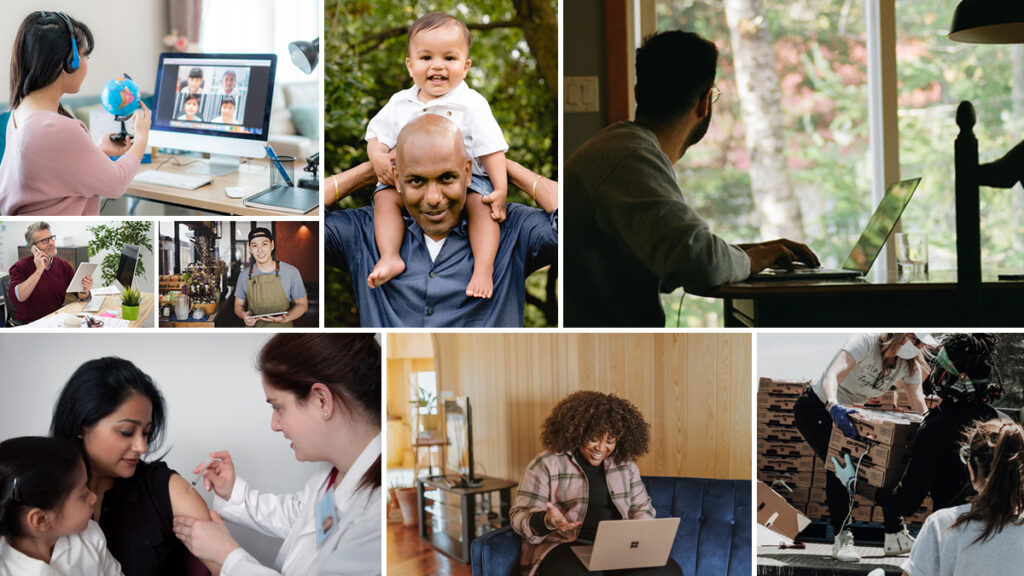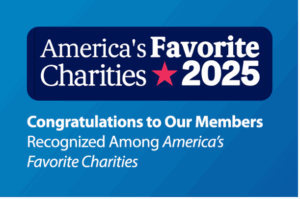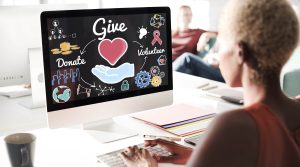Sarah Ford | March 15, 2021
One Year Later: How Businesses Stepped up Their Social Responsibility, Employee Giving, and Wellness Programs in the Face of COVID-19
It has been one year since the pandemic first prompted “stay-at-home” orders and business shutdowns.
A recent CBS News article reports, “Many economists, including policymakers at the Federal Reserve, think a broad recovery will take hold in the second half of the year once the COVID-19 vaccine is widely distributed.” A new Bankrate report shows that 44% of Americans share that sentiment. However, Bankrate’s findings also reveal that 40% expect their financial situation to remain unchanged in 2021 and 14% expect it will get worse.
Just 39% of Americans would be able to cover an unexpected $1,000 expense. When you drill down to different age brackets, only a third of millennials (the largest generation in the U.S. labor force) could turn to emergency funds to pay $1,000. By contrast, 46 percent of Gen Xers and 45 percent of baby boomers said they could cover a $1,000 emergency.
Furthermore, The Brookings Institution has shared that while the COVID-19 pandemic and associated economic shutdown created a crisis for all workers, the impact was greater for women, non-white workers, lower-wage earners, and those with less education.
COVID-19 has been devastating to nonprofits as well. Demand for their programs and services surged while critical fundraising events were suddenly canceled, putting a tremendous strain on their resources and capacity as we shared in this article about the ways America’s Charities members responded and were impacted by the pandemic early on.
Even with the initial outpouring of generosity we saw from individual donors and corporations, “More than one-third of U.S. nonprofits are in jeopardy of closing within two years because of the financial harm inflicted by the viral pandemic,” according to a new Philanthropy and COVID-19 study released by the philanthropy research group Candid and the Center for Disaster Philanthropy. Moreover, that same study found “only 5 percent of foundation and public charity funding that specified recipients was designated for Black, Indigenous, and people of color (BIPOC) communities, despite these populations being disproportionately affected by the pandemic.”
While we are finally seeing some progress in regards to COVID-19 vaccination efforts and additional pandemic relief support from the government, we have a long way to go for a full recovery.
Employers play a pivotal role in shaping the success and trajectory of that recovery.
So how are companies and their employees faring, and where do we go from here?
Between the employee giving, volunteer, matching gift, and employee relief fund programs America’s Charities manages and our alliance of some of the most reputable nonprofits in the country, our work at the nexus of employers, charities, and employee donor giving and engagement gave us a unique vantage point this past year.
I took a moment to check-in with America’s Charities president and CEO, Jim Starr, to reflect on how our clients responded to the pandemic and other major events we saw unravel last year and what we are continuing to see now.
Below we have shared insights and examples about:
- The need for employee assistance and relief fund programs in a post pandemic world,
- Models of corporate citizenship and employee compassion our team witnessed firsthand in 2020 that other workforces can easily replicate, and
- The important role workplaces play in addressing events beyond the pandemic, such as social justice, diversity and inclusion, and natural disaster recovery.
Q1:
Before the COVID-19 pandemic, America’s Charities already provided employee assistance fund (EAF) services to businesses. Given America’s Charities’ 40-year history and focus on helping employers and their employees donate to charities through workplace giving, what prompted your decision to expand that focus to employee assistance funding in a pre-pandemic world?
There were two driving factors, really.
The first factor had to do with listening. Companies kept approaching us in recent years about how to launch an EAF and whether or not America’s Charities offered EAF administration and grant application services. So we looked at the market and found there were a growing need and interest for this type of program. More and more, companies are looking for ways to expand their corporate citizenship – not just in their communities but also with their employees. Research and studies from Bankrate and other financial groups are consistently finding that a large number of Americans simply do not have the financial resources to manage an emergency. An EAF offers companies a way to help address that issue through their employee benefit and wellness programs.
The second factor was in relation to America’s Charities’ expertise and mission. We are constantly exploring ways to leverage our core competencies in new ways that further our mission and charitable purpose. With the growing need in the marketplace, offering EAF services to employers just made sense for us. The critical success factors of effective EAF administration are what we have been doing exceptionally well for 40 years. First, you must be knowledgeable of the rules and regulations that govern nonprofits – and adept at building programs under that rubric. Second, you have to have a skilled team of people who know how to review, process, and adjudicate applications against a policy or program requirements. And third, you must have the infrastructure and systems in place to process tens of thousands of grants every year. Not only does America’s Charities check all three of those boxes, but we also bring our compassion and commitment to client success to the table.
I had a great conversation with one of our EAF clients on a webinar series hosted by U.S. Chamber of Commerce Foundation Corporate Citizenship Center this past year. As a company invested in multiple restaurant, food, and health and wellness franchises – which were some of the hardest-hit businesses and employee bases early on in the pandemic – our client shared how it was helpful for them to be able to outsource their EAF program to a partner like America’s Charities. Rather than have to worry about all the administrative and legal complexities involved in managing such a program – especially with as many portfolio companies as this client wanted to help – it was nice for them to be able to focus more on spreading the word about the ways they could offer emotional, mental, and financial support to their most important asset of all: their people. It was a great 20-minute conversation that also dove into some other creative ways some of the groups under their portfolio stepped up during the pandemic, like creating a “Social Distance Safe Tutoring” group designed to help parents who were balancing their full-time jobs with the new and sudden role of teacher – something I know many of us have personally struggled with this past year. Check the conversation out if you have a moment by watching this video:
Q2:
Since the first pandemic-induced shutdown orders rolled out one year ago, what changes are you seeing in terms of employer interest and need for EAFs and COVID-19-related charitable giving efforts? Are things calming down any?
I don’t know if I’d say things are really calming down. After the initial surge of EAF interest last March and April, I’d say there has been consistent ongoing interest in EAFs. I think the pandemic put a very bright spotlight on the precarious financial position many people have been in – both before and during the pandemic. Many companies were already thinking about these programs before COVID. The pandemic basically accelerated their decision-making process. What’s interesting – and encouraging – is that while COVID has highlighted the need for EAFs, companies are launching them for a wide range of situations that create a financial hardship; not just due to COVID. This indicates that companies are putting these in place for the long haul, not just as a response to COVID. In fact, a few of our new clients who launched their EAF in December has already put it to use in response to the winter storms that hit Texas in February, providing about $50,000 in grants to help affected employees. So it just goes to show you never know when you will need an EAF or what circumstances will call for it – but having it in place means you’ll be ready to help employees immediately when the need arises. That type of commitment and investment from an employer means everything when it comes to employee retention and overall corporate culture.
On the charitable giving side, it has been a bit of a mixed bag. Several employers that had initiated conversations with us about workplace giving in 2020 had to pause those plans, understandably. Now that we are seeing progress with the pandemic and those employers have solid footing again, they have started resuming those discussions with us.
For our clients who already had an employee giving program infrastructure in place, they were able to hit the ground running with their COVID-19 response campaigns. Workplace giving programs are pretty pandemic-proof when you think about it. Since most of the giving takes place online, the question for our clients wasn’t if or how to help the community, but rather which charities to support. And for that question, our team was able to lend advice based on our nonprofit expertise, charity alliance, and understanding of each client’s special cause focus areas.
For instance, in line with its commitment to making the world healthier, a pharmaceutical company we work with allowed employees charity choice through their matching gift campaign, while also putting a spotlight on charities that help frontline healthcare workers and build capacity for the global response to discovering treatments. Other clients chose to keep their focus on supporting local food banks in their communities, while others chose to do a little bit of everything – addressing immediate needs like hunger, while supporting long term needs and solutions – by matching employee gifts made to America’s Charities Coronavirus Respond Fund.
In a time when everyone suddenly felt isolated and overwhelmed, workplace giving campaigns gave employers and employees a way to come together (virtually) and put their compassion and desire to help into action. In addition to generating more than one million dollars in pandemic relief support, those clients were able to leverage those campaigns to drive greater awareness about their giving programs and increase overall employee engagement and results.
Even in cases where our clients faced challenges due to physical distancing policies or not being able to meet in person, America’s Charities team was able to get creative and help those clients remodel their practices. For clients who historically relied heavily on paper pledge forms and in-person events where fundraising entails a lot of cash donations, this was an opportunity for America’s Charities team to help streamline those processes and even adopt new or complimentary fundraising methods like text to give.
Employee volunteer programs probably faced the biggest challenge of all for clients since a large portion of those volunteer events involved in-person activity. This caused a lot of clients to take a step back and retool their programs so employees who remained interested and dedicated to volunteering throughout the pandemic could do so. One of our clients had been considering how to apply virtual volunteering to their existing volunteer program long before the pandemic but hadn’t finished thinking it through. For them, the pandemic was just the spark they needed to get their virtual volunteering program up and running. Since the primary cause their program focuses on is early childhood education, the pandemic caused them to completely halt their volunteer program for a few months while they took the summer to pivot and regroup. By the time school started up again in fall 2020, our client was ready to help. Not only were they able to make much of their in-person volunteerism work in a virtual environment, now they had a way to include employees who hadn’t been able to participate in their program before. They were also able to incorporate new components with their program that they previously weren’t able to like in-kind gifts.
There’s a saying that “If tragedy strikes, don’t lose hope. Transform it into an opportunity to make things better.” In the face of the pandemic, that’s exactly what we saw our clients do through their various charitable giving, matching gifts, volunteering, and employee relief campaigns. And we have continued to see them do so in response to natural disasters and national events addressing social justice and inequities.
Q3:
As you just alluded to, in addition to the pandemic, 2020 was another record-breaking year of natural disasters. On top of that, with a national reckoning on issues of race, social justice, and policing, how did employers react? What kind of role are employee giving, volunteering, and EAF programs playing in regards to workforce diversity and inclusion, social justice, and the rapidly increasing number of natural disasters?
When it comes to addressing systemic racism and solving for the disproportionate impact COVID-19 and natural disasters have on BIPOC communities, the workplace provides a unique opportunity for making long-term social change.
Solving these inequities will not happen overnight, but our collective strength is the anchor to building a safe, just, and dynamic society that truly embraces diversity, equity, and inclusion.
The killings of George Floyd and Breonna Taylor catapulted racial justice issues to the forefront of the national stage last summer, and consumers demanded that brands not only speak out against racial injustice and systemic racism but also use their marketing dollars to advocate for racial equality and to educate the public on the issues. The same has been true for employers – especially when looking at expectations from Millennials and Gen Z who make up a significant portion of the workforce now. In addition to taking action in support of Black Lives Matter, employees from those generations want their employers to join them in walking the walk; not just paying lip service.
In addition to reviewing internal business policies surrounding diversity and inclusion, employers should also consider how employee giving and volunteering can play a role. By offering employees paid time off to volunteer, you can empower employees to contribute their skills and voice to advocacy efforts that advance the goals of racial justice and equality. Additionally, through programs like dollars-for-doers where the company commits to granting money to nonprofits where employees volunteer, employers can further amplify their commitment to employees and nonprofits fighting for equality, equity, and justice. A similar approach to dollars-for-doers is to match employee donations through employee giving.
In the wake of last summer’s events, we had a number of existing and new clients approach America’s Charities’ team about launching matching gift and fundraising campaigns focused on social justice, and those campaigns generated about $1.2 million for that cause within a few short months. One of the employers we work with had been wanting to launch an employee giving program for years. After listening to their employees’ interest and passion for social justice, they decided to pilot their program with a special matching gift campaign featuring charities dedicated to advancing civil rights, creating educational opportunities, fighting racism, and addressing social inequality. Now, a year later, we’re working with that company to expand their program with even more charity choices and additional ways to give. Another large client of ours decided to hold a social justice, diversity, and inclusion campaign that aligned with a specific cause they support: STEM. Their campaign supported three charities that provide STEM education and scholarship programs specifically dedicated to expanding educational access for students of diverse backgrounds. Another interesting example is from one of our clients who recognized that many of their employees already had shown support towards social justice causes. So in addition to holding a campaign where the company offered a 2-to-1 match for new donations made to charities focused on the social justice cause, the employer also committed to retroactively apply that double match to any eligible donations employees had already made earlier in that year in the months before the campaign.
How businesses can act as a force for good
What we saw in 2020 is that taking care of your employees, being engaged in your community, and creating meaningful change for society – it’s all possible. We saw employers big and small step up this past year, putting purpose and people at the center of their business practices. And we saw them do this through employee giving and assistance programs.
While we’re finally starting to see some light at the end of the tunnel with the pandemic, we know we still have far to go to build momentum with regards to social justice and civil rights. And a month from now, tornado and hurricane season will take over headlines, with the West coast’s wildfire season looming around the corner. Disasters and personal crises beyond the pandemic will continue to occur. The question is, how will employers address these issues?
All too often, employers feel pressure to fund everything and create new concepts from scratch, but that isn’t necessary. A lot of time the answer and solutions are in your own employee base – you just need to ask them about their needs and interests – and then focus your company’s initiatives based on that feedback. There are already great community organizations, solutions, and infrastructures in place to help employers and their employees help each other and the community. Really what is needed is a commitment to do so and taking that first step of reaching out to a partner like America’s Charities and asking, “What do we need to do to get started?”

Get Resources and Insights Straight To Your Inbox
Explore More Articles
Congratulations to Our Members Recognized Among America’s Favorite Charities
Each year, The Chronicle of Philanthropy releases its list of America’s Favorite Charities—the 100 nonprofits that raise the most from individual donors, foundations, and corporate…
Read ArticleThe Future of Corporate Giving: How Nonprofits Can Prepare
Corporate giving is a valuable part of the nonprofit funding ecosystem. Companies large and small have incorporated philanthropic efforts into their overall business plans, from…
Read ArticleJoin Us at the Workplace Fundraising & Volunteering Summit!
We’re excited to announce that America’s Charities President, Jim Starr, and Board Member, Fernando Lorence of JP Morgan Chase, will be speaking at the Workplace…
Read ArticleGet Resources and Insights Straight To Your Inbox
Receive our monthly/bi-monthly newsletter filled with information about causes, nonprofit impact, and topics important for corporate social responsibility and employee engagement professionals, including disaster response, workplace giving, matching gifts, employee assistance funds, volunteering, scholarship award program management, grantmaking, and other philanthropic initiatives.





